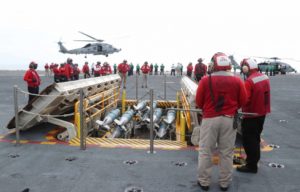Navy officials on Monday said they are seeing improved performance of new technologies aboard the USS Gerald R. Ford (CVN-78) as they work out minor faults and glitches
The Ford is currently undergoing an 18-month post-delivery test and trials (PDT&T) period consisting of 11 at-sea underway periods with portside maintenance in between. The work is set to finish in the second quarter of FY 2021 followed by full ship shock trials in summer 2021 and then a planned incremental availability.

The carrier notably features new Advanced Weapons Elevators (AWEs), Electronic Aircraft Launch System (EMALS) catapult, and Advanced Arresting Gear (AAG).
While talking to reporters during a phone conference from one at-sea period, Commanding Officer of the Ford Capt. J. J Cummings said they are now moving thousands of pounds of inert training ordnance from the aft magazine to the flight deck via the newly finished and certified AWE Lower Stage Weapons Elevator 5 (LSWE5).
LSWE5 was certified in April after many delays to the AWEs. The Navy expects the next ordnance elevator, Lower Stage Weapons Elevator 1, will be ready by the end of FY 2020 (Defense Daily, April 23).
Using LSWE5 means aircraft attached to the ship are not just launching aircraft using the EMALS and recovering them with the AAG, but also conducting more advanced training missions with non-live munitions.
Cummings said that “everything is working as advertised” with the elevator after certification.
He added that through repeated use of these new systems, “what we found is that…we have worked through some minor faults we had to iron out in the last few months. We’re working those and we found the reliability of our catapults has been up tremendously and the same for our advanced arresting gear.”
“It seems like every underway we find a different minor glitch that surfaces that needs to be addressed and we’re able to address it underway,” helped by the high number of launches and recoveries conducted over the past several months, he added
Cummings explained that “the proverbial cliché of reps and sets allows us to identify these small areas that we would not have noticed unless we’d done…2,500 cats and traps.”
The launches and recoveries are referred to as cats and traps. These are also called reps and sets for repeating sets of exercises.
He credited Naval Air Systems Command and Naval Air Warfare Center Aircraft Division Lakehurst with helping them work through issues with the AAG and EMALS.
Cummings said that “reliability is climbing” and every time the ship goes back to sea, they find areas to work on by testing and using the systems.
“You kind of want it to break, you want to find out” when you need to do onboard repairs so it can be timed right.
Cummings said the ship has “seen improved reliability for the last four underways” but was unable to cite specific data.
Assistant Secretary of the Navy for Research, Development and Acquisition James Geurts, also participating in the phone conference, said “our goal is to exercise the equipment hard and often and figure out where we’ve got opportunities to improve, whether that’s equipment or training materials or procedures and it’s really important.”
“We’re taking all those lessons learned whether its updating training material, tech data, procedures, all that and capturing that so we can continue to learn fast and improve the systems,” he added.